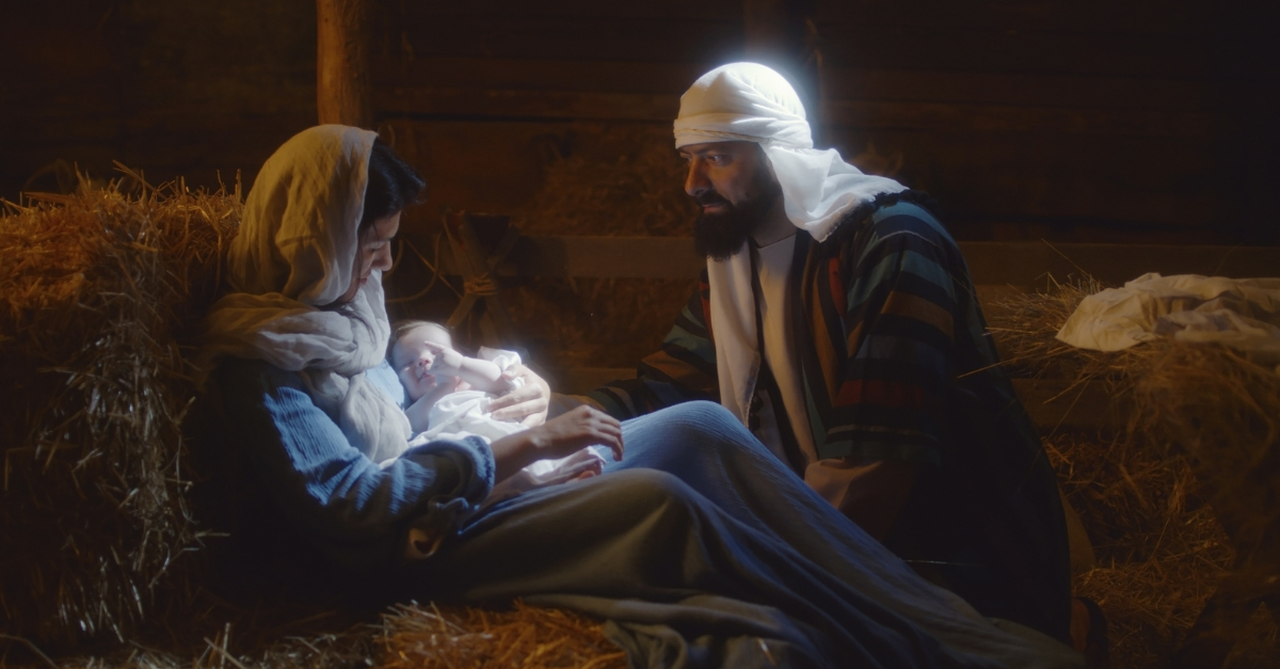5 Christmas Myths to Debunk with the Bible

Christmas is a wondrous time of celebration for people around the world. However, over the years, various myths have become associated with this beloved holiday. Debunking Christmas myths is important, so they don’t confuse or distract us. We need to focus on the real significance of Christmas – the time when God came to be with us as Jesus – to celebrate Christmas faithfully. When we debunk Christmas myths and pay attention to what matters most, we can experience God’s presence with us in fresh ways at Christmas. Here are 5 Christmas myths that we can debunk with help from the Bible:
Photo Credit: ©Getty Images/MKucova
Myth 1: Jesus was born on December 25th.

Myth 1: Jesus was born on December 25th.
SLIDE 1 OF 5
One of the most persistent myths surrounding Christmas is that Jesus was born on December 25th. While this date has been widely celebrated for centuries, the Bible does not specify the exact day of Jesus’ birth. Instead, this date was chosen to coincide with the Roman holidays Sol Invictus and Saturnalia, as well as the winter solstice. In the 4th century AD, Emperor Constantine legalized Christianity and began to promote it throughout the Roman Empire. One way he did this was to Christianize pagan holidays. Constantine declared in 336 AD that December 25th would be the official date of Christmas. By celebrating Christmas around the same time as Roman holidays and the winter solstice, the early Christians showed the pagans that they could keep their traditions while also converting to Christianity. It’s unlikely that Jesus was born on December 25th. The Bible tells us that shepherds were watching their flocks in the fields on the night of Jesus’ birth (Luke 2:8-11). This suggests that it was springtime or summertime since shepherds would not have been able to keep their flocks outside in the cold winter weather. Also, the Bible reports that there was a Roman census being conducted at the time of Jesus’ birth (Luke 2:1-5). It would have been impractical to hold a census in the winter when people would have been traveling less. Speculating on the date when Jesus was really born wastes our valuable time and energy. The Bible encourages us to focus on the birth of Jesus as a significant event in history rather than fixating on a specific date. Biblically, what’s important isn’t a date on a calendar, but how Jesus’ miraculous birth brings us hope for all time.
Photo Credit: ©Getty Images/Evgeniy Shkolenko
Myth 2: The Nativity scene represents the scene at the first Christmas.

Myth 2: The Nativity scene represents the scene at the first Christmas.
SLIDE 2 OF 5
The Nativity scene – featuring the baby Jesus in a manger, Mary, Joseph, angels, animals, shepherds, and the three wise men – is a cherished Christmas tradition started by Saint Francis of Assisi. However, it’s not entirely accurate. The Bible only mentions that Mary laid Jesus in a manger, which was a feeding trough for animals. This suggests that Jesus was born in a stable. Historians believe that it was common for people in Bethlehem to keep their animals in their homes or in stables attached to their homes. It is also possible that the stable where Jesus was born was used as a guest room for visitors. This would have been especially common during the census, when there would have been a large influx of visitors to Bethlehem. As heartwarming as it is to imagine animals with newborn Jesus, the Bible doesn’t mention any specific animals being present. It’s possible that there were animals in the stable, but it’s also possible that the manger was simply the only place available for Mary to lay Jesus down. Besides that, there is no biblical evidence that the wise men visited Jesus when he was a newborn baby. The Bible only mentions shepherds visiting the newborn Jesus, not wise men. Luke 2:15-20 describes the shepherds’ visit, but there is no biblical basis for the wise men in the Nativity scene. Finally, the Bible doesn’t give the exact number of wise men, nor does it say that the wise men were kings. Matthew 2:1-12 mentions magi (wise men) from the east visiting Jesus, but it is not associated with the Nativity. Jesus was likely older than a newborn when the wise men visited him. They came to a house to visit (Matthew 2:11), not a stable. Not only that, but the Bible doesn’t specify how many wise men there were or what their occupations were. The tradition of three kings likely comes from the fact that they brought three gifts: gold, frankincense, and myrrh. While people may assume the men were kings because of their expensive gifts, it’s also possible that the wise men were astrologers who studied the stars and figured out that the Star of Bethlehem pointed toward the birth of the world’s Savior. That could explain why they were so interested in the star that led them to Jesus.
Related Resource:
Dale and Tamara Chamberlain explore what it means to experience the abundant life that Jesus promised us by tackling ancient truths in everyday settings in their podcast Kainos Project. Listen to their episode on what we get wrong in our Christmas decorations by clicking the play button below:
Photo Credit: ©iStock/Getty Images Plus/manaemedia
Myth 3: Santa Claus has nothing to do with the true meaning of Christmas.

Myth 3: Santa Claus has nothing to do with the true meaning of Christmas.
SLIDE 3 OF 5
The legend of Santa Claus, a jolly man in a red suit who brings gifts to children around the world on Christmas Eve, has become an integral part of how many people celebrate Christmas now. Some people focus more on Santa than on Jesus at Christmas, and that is definitely a problem. In order to celebrate Christmas faithfully and grow spiritually, we should make Jesus the primary focus of our attention during Christmas. But we don’t need to eliminate Santa from our Christmas plans. It’s a myth that Santa has nothing to do with the true meaning of Christmas. Actually, the story of Santa powerfully relates to the central message of the Bible – the gift of Jesus. Santa points us to God’s ultimate gift of Jesus to humanity. Santa’s focus is on bringing children joy through giving gifts can remind us of God sending his Son to save us from our sins. Just as the Santa story says he visits children all around the world, Jesus offers salvation to every person worldwide. The famous Bible verse John 3:16 encapsulates that Gospel (good news) message: “For God so loved the world that he gave his one and only Son, that whoever believes in him shall not perish but have eternal life.” The Santa story also emphasizes the importance of putting love into action, discovering wonder, and experiencing joy at Christmas – and those are all pursuits that can strengthen our faith. We can trace the character of Santa back to a real person – Saint Nicholas of Myra, a Christian bishop who lived during the fourth century in what is now Turkey. Saint Nicholas was known for his acts of kindness, particularly his generous and secret gift-giving to families with children. The Christmas tradition of giving gifts began as a way for ancient Christians to remember the magi (wise men) who gave Jesus gifts when they visited him. Matthew 2:11 reports that the wise men brought Jesus valuable gifts of gold, frankincense, and myrrh. Those gifts symbolize important truths about Jesus. Gold symbolizes Jesus’ kingship, frankincense represents his divinity, and myrrh foreshadows his sacrificial death to save the world. Saint Nicholas would have encouraged his congregation to give gifts to each other as a way to remember the wise men’s gifts to Jesus, and God’s ultimate gift of Jesus to the world. Over the years, Christmas traditions that honored Saint Nicholas’ generosity evolved into the Santa Claus character we know today. Santa and his generous gift-giving can remind us of the ultimate gift of Jesus to our world.
Photo Credit: Alicia Slough/Unsplash
Myth 4: The popular song “Jingle Bells” is a Christmas carol.

Myth 4: The popular song “Jingle Bells” is a Christmas carol.
SLIDE 4 OF 5
Even though we often hear “Jingle Bells” playing during the Christmas season, it’s not actually about Christmas. “Jingle Bells” was originally called “One Horse Open Sleigh” when American composer James Pierpont wrote it in the 1850s. He intended the song to be about riding in a sleigh on Thanksgiving – not Christmas – but the lyrics don’t mention any particular holiday. Pierpont’s music publisher changed the song’s name to “Jingle Bells” in 1859 for marketing purposes. During the 19th century, “Jingle Bells” was often performed at Thanksgiving celebrations, which were festive occasions that involved various forms of entertainment. The song’s catchy melody and cheerful lyrics made it a popular choice for those gatherings. Over time, people began singing “Jingle Bells” during the Christmas season, since it describes a fun sleigh ride and fits in well with the joy of celebrating Christmas. The lyrics changed, though, to make them more appropriate for a Christmas carol. The original lyrics contained references to drinking alcohol and flirting between men and women. Over time, people replaced those lyrics with the current lyrics to clean up the song for family-friendly Christmas celebrations. Now, “Jingle Bells” has been translated into many different languages to be sung around the world during Christmas. Even though “Jingle Bells” wasn’t originally meant for Christmas, it’s a good choice to sing at Christmas because it's a joyful song. The Bible encourages us to sing joyfully to God in many verses, especially in the Psalms.
Photo Credit: ©GettyImages/RamilF
Myth 5: The name “Xmas” is disrespectful.

Myth 5: The name “Xmas” is disrespectful.
SLIDE 5 OF 5
The use of “Xmas” as an abbreviation for Christmas may raise concerns for some people, as it seems to replace the word “Christ” with the letter “X.” However, this abbreviation has a long history and is not meant to be disrespectful to our Christian faith. In fact, “Xmas” has its origins in early Christian symbolism and tradition. The “X” in “Xmas” represents the Greek letter “Chi,” which is the initial letter of the Greek word “Χριστός,” which means “anointed” in Greek. Early Christians used the Greek “Chi” (Χ) as a symbolic representation of Christ, and it’s commonly seen in artwork, manuscripts, and inscriptions from the early church. Over time, the practice of using “X” for “Christ” became more common in religious texts and art. So, when we see “Xmas,” it’s not an attempt to remove “Christ” from Christmas, but an abbreviation rooted in Christian history and tradition. It's a way of symbolically representing Jesus’ name that Christians have used for many centuries. Since, the “X” in “Xmas” represents an ancient symbol for Christ, “Xmas” is a legitimately faithful abbreviation for “Christmas.” The Bible tells us in Colossians 3:17: “And whatever you do, whether in word or deed, do it all in the name of the Lord Jesus, giving thanks to God the Father through him.” Whether we say “Christmas” or “Xmas”, we should do so with an attitude of gratitude to Jesus.
In conclusion, despite the fact that myths have grown up around Christmas, the wonder of God coming to be with us is real. Debunking Christmas myths can help us approach Christmas with a fresh focus on what matters most. We can experience the joy of God’s presence with us as we clear away misconceptions and center our celebrations on Jesus. Let the core message of Christmas – that God is with us – shine brightly in your heart and mind this Christmas!
Photo Credit: Unsplash/Tom Rickhuss

Originally published November 20, 2023.









